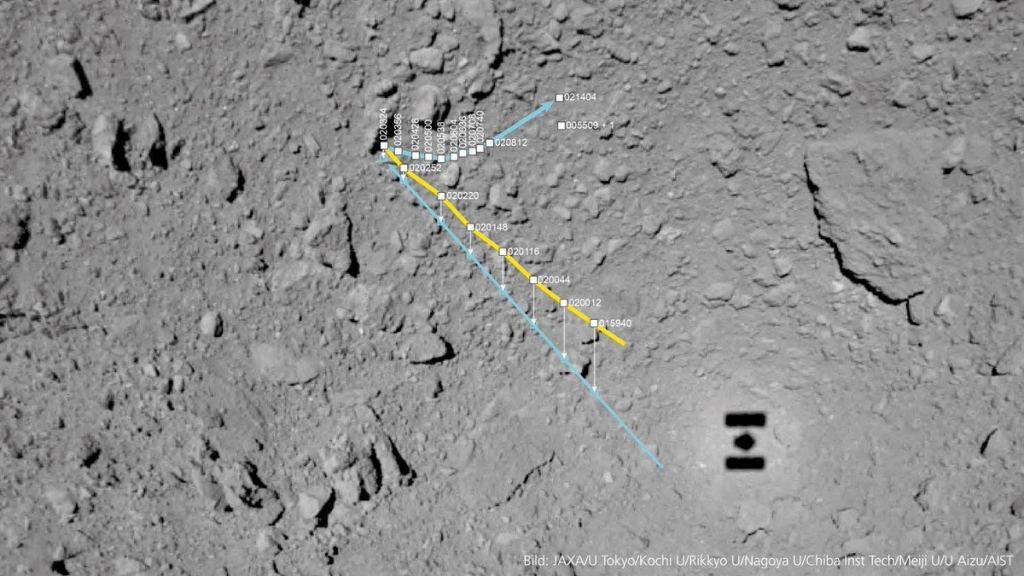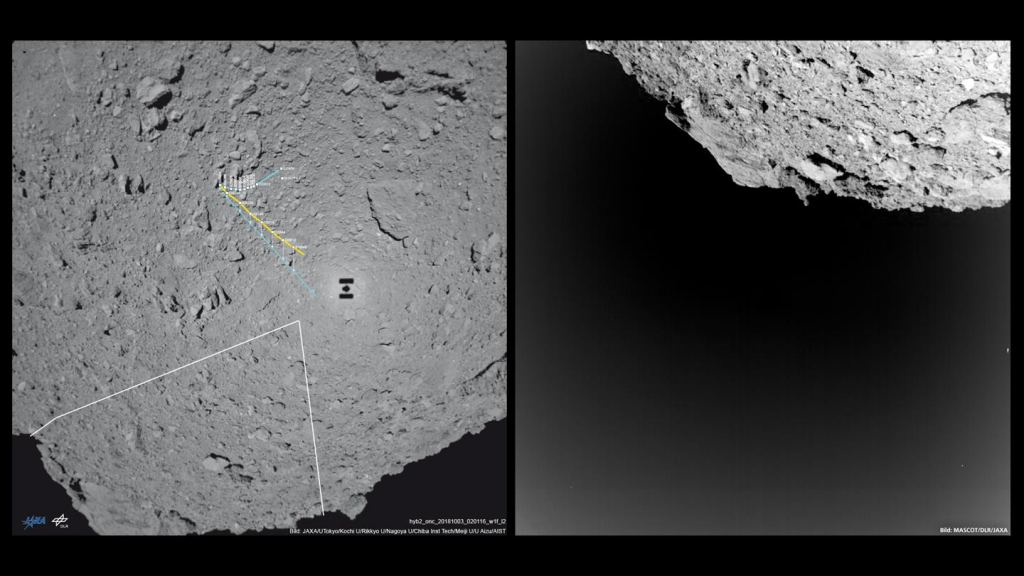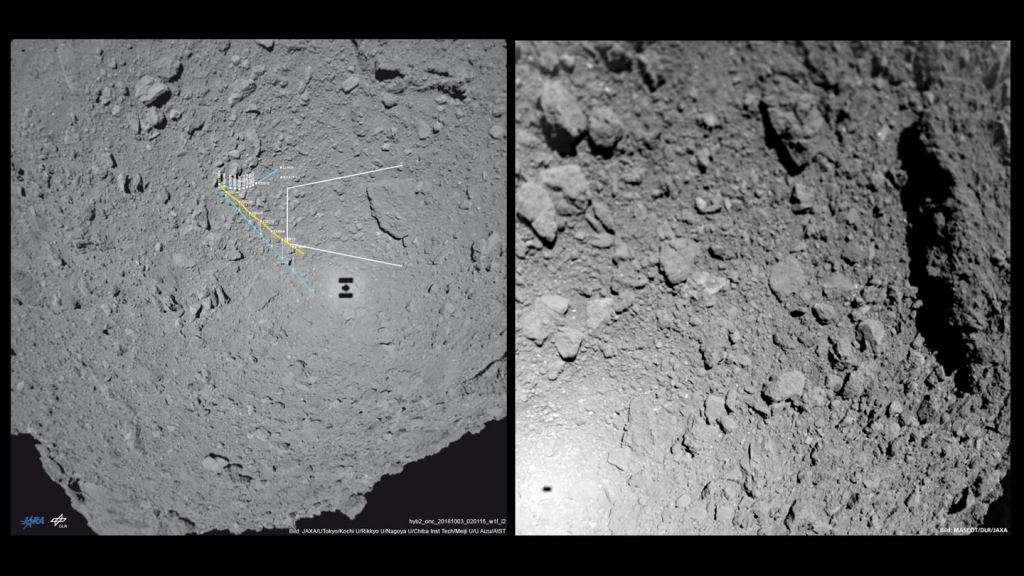The tiny hopping-robot
MASCOT
completed its 17 hour mission on the asteroid Ryugu in early October. Now the German Aerospace Center (DLR) has released an image of MASCOT's path across the asteroid. Surprised by what MASCOT found on the surface, they've named the landing spot "Alice's Wonderland."
MASCOT (Mobile Asteroid Surface Scout) was dropped onto
Ryugu
from its mother probe, the Japanese
Hayabusa2
. It's a 450 gram (1 lb.) mini-robot that measures only 30cm x 30cm x 20cm. It hopped around the surface of Ryugu by using its small tungsten swing-arm to hop from place to place.
[caption id="attachment_140249" align="alignnone" width="525"]
MASCOT's path across the surface of asteroid Ryugu. The path was recreated using data from the robot and from the mother probe Hayabusa2. Hayabusa2's shadow is visible at the bottim right. The yellow line is the robot's flight path down to the asteroid, and the blue line is the projection of these points onto Ryugu's surface. The blue line heading towards the right of the image is MASCOT's path along Ryugu's surface. Image Credit: DLR/JAXA[/caption]
The hopping-robot is a joint project between Germany, France, and Japan. It's mission was to take detailed surface measurements and readings on the asteroid. It had a projected 16 hours of battery life, but lasted 17 hours. During that time, MASCOT followed a zig-zag course that allowed it to perform its four experiments at several different locations.
[caption id="attachment_140250" align="alignnone" width="525"]
The MASCAM camera captured the image on the right during MASCOT descent to Ryugu. The white triangle in the left image shows the area covered by the image on the right. Scientist's are puzzled by the lack of fine dust and rock on the asteroid. Image Credit: MASCOT/DLR/JAXA[/caption]
When MASCOT first landed on the asteroid, it bounced eight times before coming to rest. Its resting place was not great for taking measurements, so the hopping-robot used its arm to reposition itself, according to specific commands given to it by engineers. Its second resting spot was much more suitable, and it spent one asteroid day and night there taking detailed measurements.
"In fact, it is even crazier on the surface than expected." - Ralf Jaumann, Scientific Director of the MASCOT mission.
The robot's second maneuver was a smaller 'mini-move' that allowed the MicrOmega spectrometer to take better measurements. MicrOmega measures the composition of the asteroid itself. After that, a third larger movement was executed and MASCOT took more measurements at its final location. After 17 hours, the tiny robot sent its last signal to its mothership, Hayabusa2. Its mission was complete.
"We were expecting less than 16 hours of battery life because of the cold night," says MASCOT project manager Tra-Mi Ho from the DLR Institute of Space Systems. "After all, we were able to operate MASCOT for more than one extra hour, even until the radio shadow began, which was a great success."
[caption id="attachment_140251" align="alignnone" width="525"]
MASCAM captured the image on the right as it tumbled toward Ryugu's surface. A huge boulder tens of meters wide casts a dark shadow. The image on the left contains a white open trapezoid, showing the direction of the image on the right. Image: MASCAM/DLR/JAXA[/caption]
Scientists are now examining data and images from MASCOT's mission. Ryugu's surface is boulder-strewn and covered in rough rock blocks. The lack of fine dust is surprising, and something scientists will have to puzzle through. "What we saw from a distance already gave us an idea of what it might look like on the surface," reports Ralf Jaumann from the
DLR
Institute of Planetary Research and scientific director of the MASCOT mission. "In fact, it is even crazier on the surface than expected." So crazy that the team named the landing spot "Alice's Wonderland."
"Everything is covered in rough blocks and strewn with boulders," continued Jaumann. How compact these blocks are and what they are composed of, we still do not know. But what was most surprising was that large accumulations of fine material are nowhere to be found – and we did not expect that. We have to investigate this in the next few weeks, because the cosmic weathering would actually have had to produce fine material."
"Everything is covered in rough blocks and strewn with boulders. - Ralf Jaumann, MASCOT Scientific Director.
Ryugu is one of about 17,000 near-Earth asteroids. It's considered a primordial building block of the Solar System. It's also one of the oldest bodies in our Solar System, a carbon-rich clue to how the planets formed. Along with Earth-based measurements of Ryugu, and measurements from Hayabusa2 itself, MASCOT's data will be key to understanding the asteroid's composition.
"This success was possible thanks to state-of-the-art robotic technology, long-term planning and intensive international cooperation between the scientists and engineers of the three space nations Japan, France and Germany," says Hansjörg Dittus, DLR Executive Board Member for Space Research and Technology about this milestone in Solar System exploration. "We are proud of how MASCOT was able to master its way across the asteroid Ryugu over boulders and rocks and send so much data about its composition back to Earth," says DLR Chair Pascale Ehrenfreund.
 Universe Today
Universe Today



